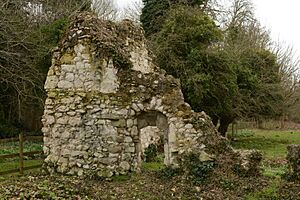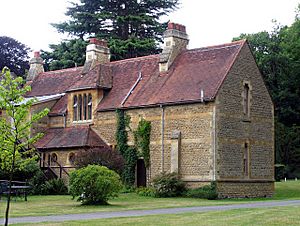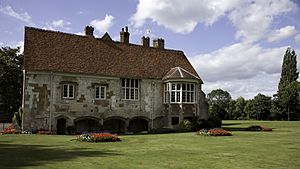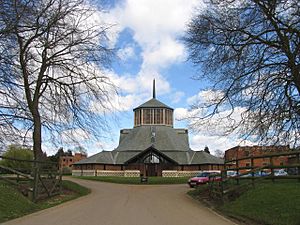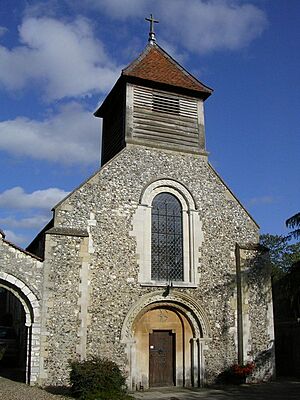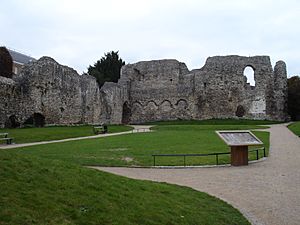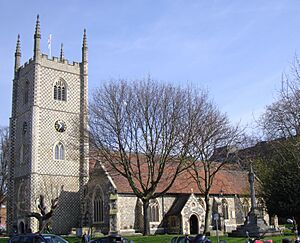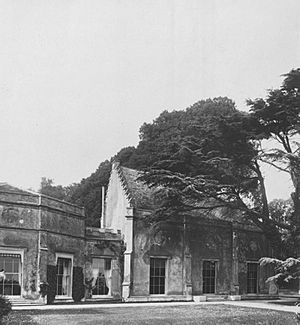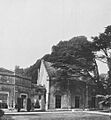List of monastic houses in Berkshire facts for kids
Monastic houses are special places where groups of people, like monks or nuns, lived together. They dedicated their lives to religious practices, prayer, and often helped their local communities. In England, many of these houses were built a long time ago, some even before the Norman Conquest in 1066! This article tells you about the different monastic houses that once existed, or still exist, in the county of Berkshire.
You can see where these old houses were located on the maps below. The first map shows the main locations across Berkshire, and the second map zooms in on the town of Reading.
This list includes different types of monastic places:
- Alien houses: These were smaller monasteries in England that were controlled by a larger monastery in another country.
- Cells: Very small monastic communities, often with just a few monks or nuns.
- Monastic granges: These were farms owned by monasteries, sometimes with monks living there to manage the land.
- Camerae: These were special places for military orders, like the Knights Templars and Knights Hospitaller. These groups were both monks and soldiers!
We haven't included hospitals here, unless they were also known as an abbey, priory, friary, or preceptory.
Alien houses are included, as are smaller establishments such as cells and notable monastic granges (particularly those with resident monks), and also camerae of the military orders of monks (Knights Templars and Knights Hospitaller). Monastic hospitals are included where they had the status or function of an abbey, priory, friary or preceptor/commandery.
- Abbreviations and key
| Symbol | Status |
|---|---|
| None | Ruins |
| * | Current monastic function |
| + | Current non-monastic ecclesiastic function (including remains incorporated into later structure) |
| ^ | Current non-ecclesiastic function (including remains incorporated into later structure) or redundant intact structure |
| $ | Remains limited to earthworks etc. |
| # | No identifiable trace of the monastic foundation remains |
| ~ | Exact site of monastic foundation unknown |
| ≈ | Identification ambiguous or confused |
Locations with names in italics indicate possible duplication (misidentification with another location) or non-existent foundations (either erroneous reference or proposed foundation never implemented) or ecclesiastical establishments with a monastic name but lacking actual monastic connection.
| EH | English Heritage |
| LT | Landmark Trust |
| NT | National Trust |
Contents
- Monastic Houses in Berkshire
- Ankerwycke Priory
- Ascot Priory
- Bisham Abbey and Preceptory
- Bradfield Abbey
- Bradley Priory
- Bromhall Priory
- Cold Ash Centre
- Cookham Abbey
- Donnington Friary
- Douai Abbey
- Greenham Preceptory
- Hurley Priory
- Kintbury Abbey
- Poughley Priory
- Reading Abbey
- Reading Nunnery
- Reading Greyfriars
- Sandleford Priory
- Shalford Preceptory
- Sheffield Lesser Priory
- Sonning Minster
- Stratfield Saye Priory
- Templeton Camera
- Images for kids
- See also
Monastic Houses in Berkshire
Ankerwycke Priory
This priory was home to Benedictine nuns. It was started around 1160 by Gilbert de Mountfitchet. The priory was closed down before 1536. Today, you can still see some of its ruins in the grounds of Ankerwycke House.
Ascot Priory
Unlike many old monastic houses, Ascot Priory is still active today! It was founded in 1861 and is home to Anglican nuns.
Bisham Abbey and Preceptory
Bisham has a long history with two different monastic groups.
- Bisham Priory: First, Augustinian Canons Regular started a priory here in 1337. It was closed in 1536.
- Bisham Abbey: Then, in 1537, King Henry VIII refounded it as an abbey for Benedictine monks. These monks had moved from Chertsey Abbey. This abbey was closed just a year later in 1538.
- Bisham Preceptory: Before the priory, the Knights Templar had a preceptory here, founded before 1139. A preceptory was like a local headquarters for these military monks. The Knights Templar group was dissolved between 1308 and 1312.
Today, the site of Bisham Abbey and Preceptory is the headquarters for the National Sports Council.
Bradfield Abbey
This was a place for monks that was recorded in 1066. King Ine of Wessex gave land to Abbot Hean of Abingdon to start a monastery here between 688 and 690. We don't know much more about it or its exact location.
Bradley Priory
This was a small place for Benedictine monks that belonged to Abingdon Abbey. It was described as a 'priory' in 1547, but its exact status and location are not fully known.
Bromhall Priory
This priory in Sunningdale was home to Benedictine nuns. It was a daughter house of Chertsey Abbey in Surrey. It was founded before 1200 by Edward, the Black Prince. Sadly, it was accidentally burnt down in 1462. It closed in 1521 when the last prioress died. The land was then given to St John's College, Cambridge. Any remains of the priory were either destroyed or built into farm buildings.
Cold Ash Centre
This is a modern monastic house for Franciscan Friars Minor and sisters. It was founded in the 1930s and is still active today as a novitiate house, where new members train.
Cookham Abbey
This was likely a 'double monastery', meaning it housed both monks and nuns. It was founded before 726. The land was given to Canterbury Cathedral, then taken by Kings Æthelbald and Coenwulf, and later given back. Today, the local church stands on what is thought to be the site of the old abbey.
Donnington Friary
This friary was for the Crouched Friars, also known as Crossed Friars. It was founded before 1404. It was closed in 1538. Today, a country house called 'The Priory' stands on the site.
Douai Abbey
This abbey is home to Benedictine monks. The community originally started in Douai, Belgium, in 1615. They moved to Woolhampton in Berkshire in 1903 and are still active today. It is known as The Abbey Church of Saint Edmund, King and Martyr.
Greenham Preceptory
This was a preceptory for the Knights Hospitaller, another military order. It was founded around 1180. The last leader (preceptor) died in 1442. By 1445, it became part of the larger estate of the prior of England. It was closed in 1540 but was briefly reopened under Queen Mary I.
Hurley Priory
This priory was for Benedictine monks. It was founded before 1087, possibly in 1065. It was given by Godfrey de Magna Villa to the Benedictines of Westminster to start a small community (a 'cell'). It was closed in 1536. Today, the nave (main part) of the old priory church is still used as a local church.
Kintbury Abbey
This might have been a Saxon abbey, minster, or small chapel. It was founded before 931. Later, in 1147, land was given to Fontevrault Benedictine nuns and brothers to start a monastery. This community later moved to Nuneaton. A plan to restart a monastery here probably never happened.
Poughley Priory
This priory was for Augustinian Canons Regular. It was founded around 1160 by Ralph de Chaddleworth. It was closed in 1524 and given to Cardinal Wolsey's college at Oxford. Some remains of the priory, like a cellar, are now part of a farmhouse, but you can't visit them.
Reading Abbey
This was a very important abbey for Cluniac monks, founded in 1121 by King Henry I. It was refounded for Benedictine monks around 1210. The abbey was closed in 1539. After it closed, its stones were used to build other things, and it was slowly taken apart between 1550 and 1643. Today, you can still see its impressive ruins.
Reading Nunnery
This was a place for nuns founded in 979. It was closed in 1016 and later given to Battle Abbey. It is believed to have been on the site where St Mary's Minster Church stands today. This church was rebuilt using stones from the demolished Reading Abbey.
Reading Greyfriars
This was a house for Franciscan Friars Minor.
- Earlier site: It was first founded in 1233.
- Later site: The friars moved to a new site between 1285 and 1286. Their church was built in 1311. It was closed on September 15, 1538. After it closed, the building was used as a hospital, a poorhouse, and even a town jail. Later, it was changed back into a parish church.
Sandleford Priory
This priory was for Augustinian Canons Regular. It was founded between 1193 and 1202. There were plans in 1274 to refound it as a double house for Fontevrault Benedictine nuns and brothers, but this never happened. It was closed in 1478. Today, the remains of the priory have been turned into a country house and are now used as an Anglican convent school.
Shalford Preceptory
This was a preceptory for the Knights Templar, founded around 1198. After the Knights Templar were dissolved, it passed to the Knights Hospitaller. By 1338, it had become part of the Greenham Preceptory.
Sheffield Lesser Priory
This was a small place for Benedictine monks. It was an 'alien house', meaning it was controlled by a monastery in France. It was founded after 1086. It was known locally as a 'priory' but was more like a large farm (manor-grange). It was closed around 1166-1167 and later passed to Reading Abbey in 1270.
Sonning Minster
This was a Saxon minster, which was an early type of monastery or church center. It was held by the Bishop of Ramsbury/Sherborne in the 10th and 11th centuries. The current local church dates back to the 9th century, but it was largely rebuilt in the 1800s.
Stratfield Saye Priory
This was another 'alien house' for Benedictine monks, controlled by Valmont Abbey in France. It was founded in 1169 or 1170. It started as a hermitage (a place for a hermit) and was given to Valmont. It was closed in 1399. Today, a house called 'The Priory' stands on the site.
Templeton Camera
This was a place for the Knights Templar, possibly a small hospice or hostel with a chapel. After the Knights Templar were dissolved, it passed to the Knights Hospitaller in 1311. By the time of the Dissolution of the Monasteries, it was privately owned. A large house called 'Templeton House' was built on the site in 1895.
Images for kids
See also


